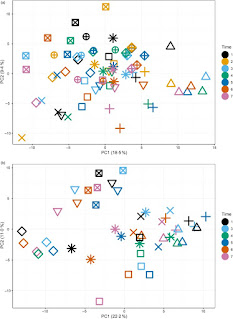Metabolomic profiling to identify effects of dietary calcium reveal the influence of the individual and postprandial dynamics on the canine plasma metabolome.
Short-term studies have highlighted the phenomenon meal in the regulation of Ca salary increase concerns about the absorption of Ca in dogs that can make an impact on the commercial diet close to the maximum recommended levels. A recent G.Pig Plasma study to determine the response of the dog ate one of two diets differed in Ca diet over 40 weeks did not find evidence that shows concerns in the various hypotheses of biological parameters will be affected by Ca. An unexpected consequence of food Ca could occur and metabolic profile is considered data-driven approach that is suitable to identify the effects of Ca.
The goal is to compare the diet fasting plasma metabolome (sampled at intervals of 8 weeks more than 40 weeks) dog ate one of two diets, close to the minimum and the maximum recommended level of Ca. Comparison with diet control diet was also investigated in the course of time postprandial (1-4 h) following acute (1 d) and long term (24 weeks) fed a diet test. Comparing the fasting plasma samples at each time point, no significant effect (adjusted P <0 · 05) in the diet of metabolites were observed.
In the postprandial state, only phosphate consistently differ between the diet and is explained by the additional P diet to keep the Ca: P metabolic profile analysis supports the view that dietary Ca safe upper limit. In addition, the plasma metabolome marked dog, gives an insight into the stability of individual profiles in 40 weeks, in response to the consumption of nutritionally complete foods for 4 hours postprandial time course and kinetic different categories of postprandial absorption.
Carbon monoxide releasing molecules Increase of coagulation and fibrinolysis decrease in plasma dogs Crotalus viridis exposed to toxins in vitro and in vivo.
arbon monoxide releasing molecule-2 (tuber-2), a therapy that appears in human medicine, improving coagulation plasmatic and attenuates fibrinolysis in vitro human, rabbit and plasma of horses and ameliorates hypocoagulation and hyperfibrinolysis secondary to exposure to toxins in human plasma in vitro.
Fibrinogenases in rattlesnake venom causes a decrease clot strength, and in the presence of tissue plasminogen activator (tPA) in vitro, the real rate of increase in clot lysis. CO interacts with the heme group on fibrinogen, change the configuration so that fibrin clot strengthened and more resistant to fibrinolysis. We hypothesize that the tuber-2 Increased coagulation and fibrinolysis plasma attenuates in dogs exposed to C. viridis venom.
We measured the effects of C. viridis venom on clot strength, the level of coagulation and fibrinolysis in both dogs plasma and plasma collected from individual dogs G.Pig Serum poisoned naturally, with and without tuber-2, using thromboelastography (TEG). We tested the toxic effects on coagulation using tissue factor (TF) is activated TEG and on both coagulation and fibrinolysis using TF-activated TEG by adding tPA.

Comments
Post a Comment